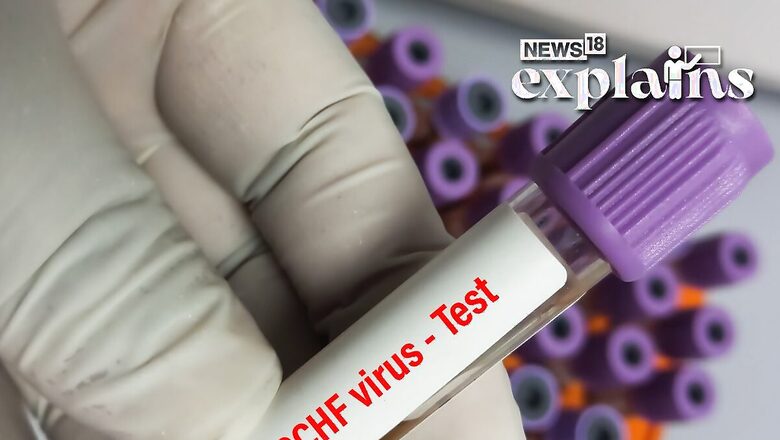
views
Europe is currently grappling with a severe heatwave and devastating wildfires, which have raised concerns about the spread of viruses that are typically not found in colder climates. Among these worries is the alert sounded by the World Health Organization (WHO) about the potential transmission of Crimean-Congo haemorrhagic fever (CCHF), a tick-borne infection known for its high fatality rate, as per a report by Indian Express.
Traditionally endemic to Africa, the Balkan countries, the Middle East, and parts of Asia, CCHF claimed its first victim in Europe in 2016, in Spain. Now, scientists are issuing warnings that CCHF is gradually spreading northward and westward across the continent, posing a significant threat to public health.
Spread of CCHF in Europe
Cases of CCHF have been reported in several European countries, including Spain, Russia, Turkey, and the UK. This infectious disease, with a mortality rate ranging from 10% to 40% among patients, is becoming increasingly prevalent in Europe. Scientists have observed a concerning trend as the disease expands its geographical range.
Have There Been any Cases in India?
In India, the state of Gujarat has reported the majority of CCHF cases within the country. Last month, one person succumbed to CCHF in Gujarat, highlighting the presence of the disease within India’s borders.
What Exactly is CCHF?
Crimean-Congo haemorrhagic fever (CCHF) is a widespread disease caused by a virus transmitted through ticks. It leads to severe outbreaks of viral haemorrhagic fever, with a case fatality rate ranging from 10% to 40%.
How is it Transmitted?
CCHF is primarily transmitted to humans through tick bites or contact with infected animal blood or tissues during and after slaughter. The virus is endemic in regions such as Africa, the Balkans, the Middle East, and Asian countries located below the 50th parallel north.
A variety of wild and domestic animals, including cattle, sheep, and goats, can carry the CCHF virus without showing any signs of illness. Birds are generally resistant to infection, but ostriches can carry and transmit the virus, which has led to human cases in endemic areas. The virus persists in animals’ bloodstream for about a week, allowing ticks of the Hyalomma genus to continue the transmission cycle when they bite, as per a report by WHO.
Where are Most Cases Reported?
Most cases of CCHF occur in individuals involved in the livestock industry, such as agricultural workers, slaughterhouse workers, and veterinarians. Tick bites and contact with infected animal blood or tissues are the primary modes of transmission. Human-to-human transmission can also occur through close contact with the blood, secretions, organs, or bodily fluids of infected individuals. Improper sterilization of medical equipment, needle reuse, and contaminated medical supplies can result in hospital-acquired infections, as per the report.
What are the Signs and Symptoms?
The incubation period for CCHF depends on how the virus was acquired. Following a tick bite, symptoms usually appear within one to three days, with a maximum of nine days. After contact with infected blood or tissues, the incubation period is typically five to six days, with a maximum of 13 days.
Symptoms manifest suddenly and include fever, muscle aches, dizziness, neck and back pain, headache, sore eyes, and sensitivity to light. Early on, individuals may experience nausea, vomiting, diarrhea, abdominal pain, sore throat, and mood swings. As the disease progresses, agitation may be replaced by sleepiness, depression, lassitude, and abdominal pain localized in the upper right quadrant with liver enlargement.
Other clinical signs include a rapid heart rate, enlarged lymph nodes, and a rash caused by bleeding into the skin, known as petechiae. The petechiae may develop into larger rashes called ecchymoses, along with other haemorrhagic phenomena. Patients may also show evidence of hepatitis, and those severely ill may experience kidney deterioration, liver failure, or pulmonary failure in the later stages of the illness.
The mortality rate for CCHF is approximately 30%, with fatalities occurring during the second week of illness. Patients who recover generally begin to show improvement around the ninth or tenth day after the onset of symptoms.
How is the Disease Diagnosed and Is There Any Vaccine?
Various laboratory tests can be used to diagnose CCHF virus infection, including enzyme-linked immunosorbent assay (ELISA), antigen detection, serum neutralization, reverse transcriptase polymerase chain reaction (RT-PCR) assay, and virus isolation by cell culture. However, in patients with fatal disease or in the early stages of illness, an antibody response may not be detectable. In such cases, diagnosis is achieved by detecting the virus or its RNA in blood or tissue samples.
Currently, there is no widely available and effective vaccine for human use against CCHF. Although a vaccine derived from inactivated mouse brain tissue has been developed and used on a limited scale in eastern Europe, safety concerns restrict its widespread use.
How to Prevent an Infection
In the absence of a vaccine, raising awareness of risk factors and educating people about preventive measures is crucial to reduce CCHF infection.
Reducing Tick-to-Human Transmission:
- Wear protective clothing such as long sleeves and trousers.
- Opt for light-colored clothing to easily spot ticks.
- Use approved acaricides (tick-killing chemicals) on clothing.
- Apply approved repellents on the skin and clothing.
- Regularly check clothing and skin for ticks and safely remove any found.
- Take steps to eliminate or control tick infestations in animals, stables, and barns.
- Avoid areas with high tick abundance and during their most active seasons.Reducing Animal-to-Human Transmission:
- Wear gloves and protective clothing when handling animals or their tissues, especially during slaughtering, butchering, and culling procedures, whether at slaughterhouses or home settings.
- Quarantine animals before they enter slaughterhouses or treat them routinely with pesticides two weeks prior to slaughter.Reducing Human-to-Human Transmission:
- Avoid close physical contact with individuals infected with CCHF.
- Use gloves and protective equipment when caring for sick people.
- Wash hands regularly after providing care or visiting ill individuals.

















Comments
0 comment